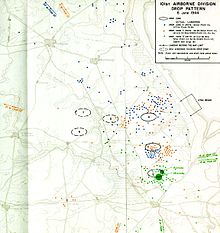Mission Albany
The division took most of its objectives on D-Day, but required four days to consolidate its scattered units and complete its mission of securing the left flank and rear of the U.S. VII Corps, reinforced by 2,300 glider infantry troops who landed by sea.The serials began to take off at 22:30 on June 5, assembled into formations, and flew southwest over the English Channel at 500 feet (150 m) MSL to remain below German radar coverage.A solid cloud bank over the western half of the 22-mile (35 km) peninsula at penetration altitude (1500 feet MSL), an opaque ground fog over many drop zones, and intense German antiaircraft fire ("flak") broke up and dispersed many formations.The commanders of the 1st and 3rd Battalions, Lieutenant Colonels Patrick F. Cassidy and Robert G. Cole, took charge of small groups and accomplished all of their D-Day missions.Cassidy's group took Saint Martin-de-Varreville by 06:30, sent a patrol under Staff Sergeant Harrison C. Summers to seize the "XYZ" objective, a barracks at Les Mézières, and set up a thin line of defense from Foucarville to Beuzeville-au-Plain.Muir held the aircraft steady while the men jumped, then died when the plane crashed immediately afterward, for which he was awarded the Distinguished Service Cross.The 2nd Battalion, much of which had jumped too far west near Sainte Mère Église, eventually assembled near Foucarville at the northern edge of the 101st Airborne Division's objective area.[4] After a six-hour house-clearing battle with elements of the German 1058th Grenadier Regiment, the group secured the exit shortly before 4th Division troops arrived to link up.[5] The surviving battalion commander, Lieutenant Colonel Robert A. Ballard, gathered 250 troopers and advanced toward Saint Côme-du-Mont to complete his mission of destroying the highway bridges over the Douve.After establishing defensive positions, Colonel Johnson went back to the drop zone and assembled another 100 men, including Allen's group, to reinforce the bridgehead.[6] The S-3 officer of the 3rd Battalion, 506th, Captain Charles G. Shettle, put together a platoon and achieved another objective by seizing two foot bridges near la Porte at 04:30 and crossed to the east bank.Two other noteworthy actions took place near Sainte Marie-du-Mont by units of the 506th PIR, both of which involved the seizure and destruction of batteries of 105mm howitzers of the German III Battalion-191st Artillery Regiment.During the morning, a squad-size patrol of troopers, mainly from Company E of the 506th PIR under First Lieutenant Richard Winters overwhelmed a force three or four times its size and destroyed four guns at Brécourt Manor.Taylor had control of about 2,500 of his 6,600 men, most of which were in the vicinity of the 506th's command post at Culoville, with the thin defense line west of Saint Germain-du-Varreville, or the division reserve at Blosville.The 101st Airborne Division had accomplished its most important mission of securing the beach exits, but had a tenuous hold on positions near the Douve River, over which the Germans could still move armored units.The first, at Saint Côme-du-Mont, was to complete its objective of blocking possible German counterattacks from south of the Douve River and is considered part of its original airborne mission.The town was defended by a line of troops of the 3rd Battalion 1058th Grenadier Regiment (III./1058) in prepared positions from les Droueries to Basse-Addeville, who had stopped the advance of the 2/501st on D-Day.As the battle developed during the day, the commander of FJR6, Oberstleutnant Friedrich von der Heydte, brought up half of his 3rd Battalion from Carentan to reinforce the III./1058 and took over defense of the highway.Using a newly arrived Stuart light tank as support, Company D advanced at 1830 two miles (3 km) to the battalion objective, the crossroads below Saint Côme-du-Mont linking it with Carentan.Although mop-up attacks captured the 6th's Fallschirmjäger's regimental train of 40 carts, most of the defenders escaped, blowing up the second of the four causeway bridges and a portion of the railroad embankment in the process.



American airborne landings in NormandyOperation OverlordU.S. 101st Airborne DivisionNormandyAmericanUnited StatesNazi GermanyMaxwell D. TaylorFriedrich von der Heydte746th Tank Battalion6th Fallschirmjager RegimentAtlantic WallBodyguardFortitudeZeppelinTitanicTaxable, Glimmer & Big DrumCombined Bomber OffensivePointblankTransport PlanPostage AbleTarbrushFabiusCaen canal and Orne river bridgesMerville BatteryMallardAmerican SectorBostonChicagoDetroitElmiraNormandy landingsPointe du HocGambitPort-en-BessinOperation ChastityBritishMulberryBrécourt ManorGraignesLa Haye-du-PuitsSaint-LôCarentanHill 30CherbourgBrévilleVillers-BocageLe Mesnil-PatryNormandy massacresArdenne AbbeyDouvresMartletWindsorCharnwoodJupiter2nd OdonAtlanticGoodwoodVerrières RidgeSpringBluecoatTotalizeHill 140LüttichTractableHill 262ChamboisFalaiseSaint-MaloMantes-GassicourtLa RochelleUshantLa CainePierres NoiresAudierne BayJedburghDingsonSamwestCooneyBulbasketHoundsworthLoytonKiplingDragoonWallace & HardyCemeteriesWorld War IIOperation NeptuneAlliedinvasion of NormandyparatroopersC-47 SkytrainCotentin PeninsulaU.S. VII Corpsglider infantryUtah BeachSaint-Martin-de-VarrevilleDouve RiverU.S. 82nd Airborne Division709th Infantry DivisionGeneralDwight D. EisenhowerFirst lieutenantWallace Strobel502nd Parachute Infantry RegimentMission BostonSainte-Mère-Église501st Parachute Infantry Regiment"vee's of vee's"439th Troop Carrier Group506th Parachute Infantry RegimentpathfindersEureka radar transponder beaconsEnglish ChannelChannel IslandsGuernseyAlderneyPortbailground fogBritish Double Summer TimePatrick F. CassidyRobert G. ColeStaff SergeantHarrison C. SummersFoucarvilleBeuzeville-au-Plain